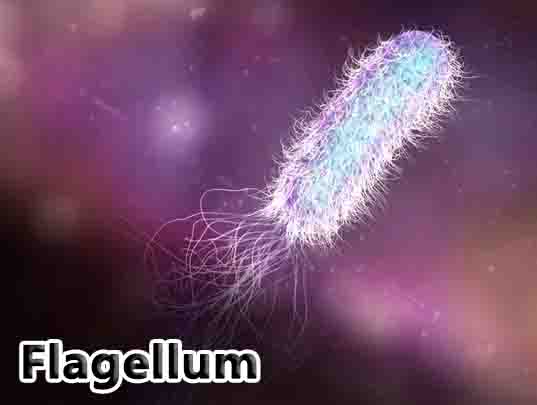Flagellum Definition
Flagellums are microscopic organelles that help cells and microorganisms move. In Latin, flagellum means whip, similar to the whipping motion flagella (plural) frequently use for locomotion. In some organisms, specialized flagella function as sensory organelles that detect temperature and pH changes.
Function of Flagellum
A flagellum is a filamentous protein structure found in bacteria, archaea, and eukaryotes, although they are most common in bacteria. It is typically used to propel a cell through liquid (e.g. bacteria and sperm). Other specialized functions are also performed by flagella. Flagellums are used by some eukaryotic cells to increase their reproduction rate.
Eukaryotic and bacterial flagella sense changes in the environment, such as changes in temperature or pH. The flagellum may also function as a secretory organelle in the green alga Chlamydomonas reinhardtii, but more research is needed to fully understand it.
Examples of Flagellum
In eukaryotes and bacteria, flagellums can have different structures depending on the organism. The attached flagellum of eukaryotes is also complex because they are typically complex organisms. A protein called tubulin composes the microtubules that make up the flagellum.
The nine-plus-two arrangement of microtubules forms the core of the flagellum, which consists of nine pairs surrounding two pairs. Within the organism, a basal body anchors the nine-plus-two structure. Microtubules bundled together bend back and forth in a whip-like motion using ATP.
Despite the fact that few multicellular eukaryotes possess flagellums, almost half of all humans produce them as sperm. There is only one flagellum in the human body, and for good reason. As sperm move through the vaginal tract to meet the egg, they need to be able to move very far (compared to their size). Fertilization and population stability would be very difficult without the flagellum.
In contrast, bacterial flagella are structured and function completely differently from their eukaryotic counterparts. The flagella are made up of a protein called flagellin. ATP is not needed because the proton-motive force provides enough energy for the bacterial flagellum. In other words, the energy comes from ion gradients, usually hydrogen or sodium, which lie across the membranes of the cells.
Helix-shaped flagella rotate quickly like windmills instead of whipping back and forth to move the organism. In order to cause urinary tract infections, Escherichia coli uses a windmill-like locomotion to propel itself up the urethra. Several windmill-like flagella are used by Salmonella enterica to infect humans.
Types of Flagellum
A flagellar structure consists of three parts: rings embedded in the basal body, a hook near the surface, and filaments of flagellar protein.
There are three things that every flagellum has in common, regardless of the organism. Based on their location, bacterial flagellum can be classified into four types:
A monotrichous organism has a single flagellum at one end or the other.
There are several flagellums on one or both ends of the organism in the case of a lophotrichous organism.
Amphitrichous: An organism with a single flagellum on both ends.
There are several flagellum attached to the organism all over it in D. Peritrichous.
A monotrichous, amphitrichous, or lophotrichous flagellum is considered a polar flagellum since it is strictly located at the ends of the organism. In addition to rotating clockwise, these flagella can also rotate counterclockwise. Organisms (or cells) move forward in a clockwise direction, while they move backward in a counterclockwise direction.
Peritrichous flagella are not considered polar because they are found throughout the organism. During counterclockwise rotation, these flagella form a bundle that propels the organism forward. When a few flagellum break off and begin rotating clockwise, the organism tumbles. The organism cannot move during this time.
Regardless of the polarity of the flagellum, an organism will change direction if it stops rotating. The organism is spun around by Brownian motion (constant movement of liquid particles) and fluid currents. Those organisms that cannot change direction on their own rely on Brownian motion and fluid currents.
Related Biology Terms
- ATP – Adenosine triphosphate, a small molecule used in cells as a coenzyme that transfers energy.
- Microtubules – A microscopic tubular structure present in the cytoplasm of cells that helps form the cytoskeleton.
- Basal body – An organelle that forms the very base of a flagellum; it is similar to a centriole in structure.
- Brownian motion – The random movement of particles in a fluid (liquid or gas), caused by bumping into other molecules within the same fluid.

